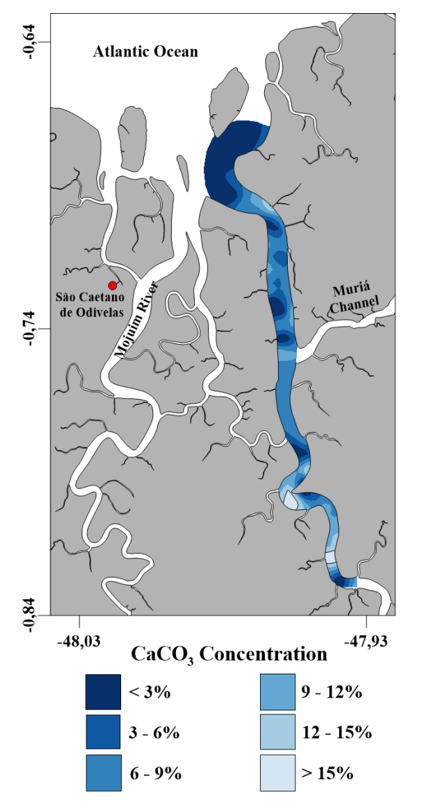If you have been following the OCA, you already know the Mocajuba estuary. Previously, we told you that in the dry period, saline intrusion reaches approximately 30 km in the estuary (Gomes, 2018). Usually, in places with strong saline intrusions, there is the formation of marine organisms communities into the estuarine channel.
The Mocajuba estuary is no different. These organisms can settle in the sediment, forming natural oyster banks, and even settle in the roots of the mangroves! The local population collects oysters and crabs, called extractive production, as well as mariculture, which is the cultivation of these organisms. Also, the existence of these “older” organisms allows the settlement of new organisms, the “juveniles”, continuing the occupation cycle of the banks and mangroves roots. Wonderful isn't it?
The marine intrusion registration and the occupation of marine organisms were also observed from sedimentological analyzes, studied by Pereira (2018). In other words, the author collected sediment from the bottom of the Mocajuba estuary and performed several analyzes with this material. The result? High content of calcium carbonate estuary above.
You may be wondering, what is Calcium Carbonate and what is it doing at the estuary bottom? Well, the answer is quite simple. You may have seen some shells while walking on the beach. These shells are originated from marine organisms, which can make an external shell, where the main component is calcium carbonate (Figure 1). Some examples are from the phylum Mollusca:

Figure 1. (A) Cephalopod mollusk, Nautilus. Source: https://oceana.org/blog/doomed-their-beauty-nautiluses-could-be-headed-toward-extinction. (B) Monoplacophore mollusk. Source: http://www.conchasbrasil.org.br/materias/monoplacophora/monoplacophora.asp.

Figure 2. The calcium carbonate distribution in the Mocajuba estuary, Pará.
Then, when these organisms die, the carapace sinks, reaching the estuary bottom, the sea, or the ocean, and then, that carapace becomes a part of the sediment. According to Pereira (2018), calcium carbonate was found up to approximately 25 km away from the estuary mouth! Thus, through sediment, it can affirm that the Mocajuba estuary has a strong marine influence (Figure 2).
Interesting, isn't it? If you want to know more about our wide Amazon coast, stay tuned to OCA-Highlight!
References
Gomes, Jacqueline Ellen Pinheiro. 2018. EXTENSÃO DA INTRUSÃO SALINA NO ESTUÁRIO MOCAJUBA E SUA INFLUÊNCIA NOS PARÂMETROS FÍSICO QUÍMICOS E QUALIDADE DA ÁGUA. Trabalho de Conclusão de Curso (Graduação) – Faculdade de Oceanografia, Instituto de Geociências, Universidade Federal do Pará. Disponível em: http://bdm.ufpa.br/jspui/handle/prefix/1268
Pereira, Débora Rodrigues. 2018. LIMITAÇÕES DA SETORIZAÇÃO SEDIMENTAR DO ESTUÁRIO MOCAJUBA. Trabalho de Conclusão de Curso (Graduação) – Faculdade de Oceanografia, Instituto de Geociências, Universidade Federal do Pará. Disponível em: http://bdm.ufpa.br/jspui/handle/prefix/856
